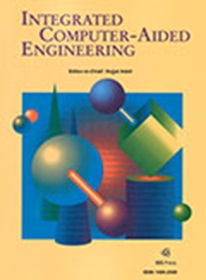Virtual sensor for probabilistic estimation of the evaporation in cooling towers
IF 5.3
2区 计算机科学
Q1 COMPUTER SCIENCE, ARTIFICIAL INTELLIGENCE
引用次数: 0
Abstract
Global natural resources are affected by several causes such as climate change effects or unsustainable management strategies. Indeed, the use of water has been intensified in urban buildings because of the proliferation of HVAC (Heating, Ventilating and Air Conditioning) systems, for instance cooling towers, where an abundant amount of water is lost during the evaporation process. The measurement of the evaporation is challenging, so a virtual sensor could be used to tackle it, allowing to monitor and manage the water consumption in different scenarios and helping to plan efficient operation strategies which reduce the use of fresh water. In this paper, a deep generative approach is proposed for developing a virtual sensor for probabilistic estimation of the evaporation in cooling towers, given the surrounding conditions. It is based on a conditioned generative adversarial network (cGAN), whose generator includes a recurrent layer (GRU) that models the temporal information by learning from previous states and a densely connected layer that models the fluctuations of the conditions. The proposed deep generative approach is not only able to yield the estimated evaporation value but it also produces a whole probability distribution, considering any operating scenario, so it is possible to know the confidence interval in which the estimation is likely found. This deep generative approach is assessed and compared with other probabilistic state-of-the-art methods according to several metrics (CRPS, MAPE and RMSE) and using real data from a cooling tower located at a hospital building. The results obtained show that, to the best of our knowledge, our proposal is a noteworthy method to develop a virtual sensor, taking as input the current and last samples, since it provides an accurate estimation of the evaporation with wide enough confidence intervals, contemplating potential fluctuations of the conditions.用于冷却塔蒸发量概率估计的虚拟传感器
全球自然资源受到若干原因的影响,例如气候变化的影响或不可持续的管理战略。事实上,由于诸如冷却塔等暖通空调系统的普及,城市建筑物的用水已经加强,因为在蒸发过程中大量的水流失了。蒸发的测量具有挑战性,因此可以使用虚拟传感器来解决这个问题,允许监控和管理不同场景下的用水量,并帮助规划有效的操作策略,减少淡水的使用。本文提出了一种深度生成方法,用于开发虚拟传感器,用于给定周围条件下冷却塔蒸发量的概率估计。它基于条件生成对抗网络(cGAN),其生成器包括一个循环层(GRU),该层通过从以前的状态学习来模拟时间信息,以及一个密集连接层,该层模拟条件的波动。所提出的深度生成方法不仅能够产生估计的蒸发值,而且能够在考虑任何操作场景的情况下产生一个完整的概率分布,因此可以知道估计可能存在的置信区间。根据几个指标(CRPS、MAPE和RMSE),并使用位于医院大楼的冷却塔的真实数据,对这种深度生成方法进行评估,并与其他最先进的概率方法进行比较。结果表明,据我们所知,我们的建议是开发虚拟传感器的一个值得注意的方法,将当前和最后的样本作为输入,因为它提供了对蒸发的准确估计,具有足够宽的置信区间,考虑了条件的潜在波动。
本文章由计算机程序翻译,如有差异,请以英文原文为准。
求助全文
约1分钟内获得全文
求助全文
来源期刊

Integrated Computer-Aided Engineering
工程技术-工程:综合
CiteScore
9.90
自引率
21.50%
发文量
21
审稿时长
>12 weeks
期刊介绍:
Integrated Computer-Aided Engineering (ICAE) was founded in 1993. "Based on the premise that interdisciplinary thinking and synergistic collaboration of disciplines can solve complex problems, open new frontiers, and lead to true innovations and breakthroughs, the cornerstone of industrial competitiveness and advancement of the society" as noted in the inaugural issue of the journal.
The focus of ICAE is the integration of leading edge and emerging computer and information technologies for innovative solution of engineering problems. The journal fosters interdisciplinary research and presents a unique forum for innovative computer-aided engineering. It also publishes novel industrial applications of CAE, thus helping to bring new computational paradigms from research labs and classrooms to reality. Areas covered by the journal include (but are not limited to) artificial intelligence, advanced signal processing, biologically inspired computing, cognitive modeling, concurrent engineering, database management, distributed computing, evolutionary computing, fuzzy logic, genetic algorithms, geometric modeling, intelligent and adaptive systems, internet-based technologies, knowledge discovery and engineering, machine learning, mechatronics, mobile computing, multimedia technologies, networking, neural network computing, object-oriented systems, optimization and search, parallel processing, robotics virtual reality, and visualization techniques.
 求助内容:
求助内容: 应助结果提醒方式:
应助结果提醒方式:


